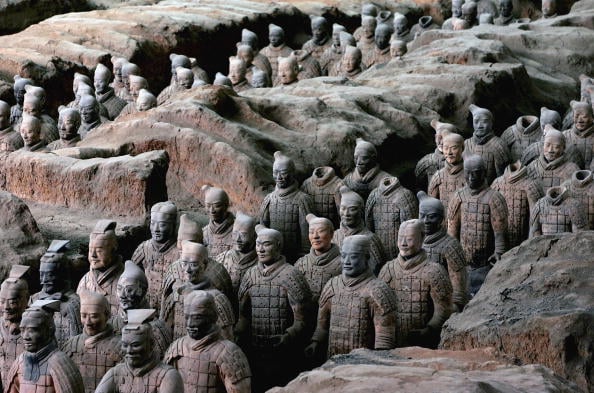Art & Exhibitions
China’s Famed Terracotta Warriors Come to the Metropolitan Museum of Art
"Age of Empires" promises a truly epic look at classical Chinese culture.

"Age of Empires" promises a truly epic look at classical Chinese culture.

Kiki Olmedo

If China’s Colosseum is the Great Wall, then its David—or more accurately, its Davids—is its famed army of Terracotta Warriors. A group of the breathtaking life-size soldiers that guarded Emperor Qin Shihuang’s tomb for over two millennia will be part of a “reception committee” from the afterlife at New York’s Metropolitan Museum of Art at its upcoming exhibition of more than 160 ancient works of Chinese art.
The museum’s outgoing director, Thomas Campbell, issued a statement calling the show “the largest and most important display of Chinese art to be held in the United States in 2017.”
The sublime guardians were discovered in 1974 by a farmer who was digging a well, only to stumble on a buried army thousands strong. At the Met, visitors will be able to see one of the statues with very rare traces of pigment, as well as a semi-nude figure of outstanding anatomical accuracy that betrays influences from Western Art, first introduced by Alexander the Great.
Throughout the exhibition’s three sections, visitors will also find ritual vessels, musical instruments, lacquerware, and silk textiles. Other highlights will include a 2,000-piece jade burial suit for a Han princess, a monolithic column with carved dragons, and a monumental sculpture of a crouching lion—a creature not native to China, once again demonstrating cultural exchange with the West.
The exhibition will provide an overview of what Jason Sun, curator of Chinese art in the Met’s Department of Asian Art, refers to as the “‘classical’ era of Chinese civilization.” In terms of its cultural footprint, the period spanning from 221 BC to 220 AD in China bears some resemblance to the Greco-Roman epoch in the West. The Chinese identity we know today is rooted in the Qin and Han Dynasties, which managed to unite the different ethnicities of the territory under a centralized government that brought new political stability and economic growth to the region.
Seven years in the making, the exhibition is the Met’s latest programming organized in collaboration with 32 cultural institutions from China. It comes on the heels of the record-breaking attendance of the exhibition “China: Through the Looking Glass” in 2015.
A full program of lectures, as well as an illustrated catalogue, will accompany the exhibition, which wasalready being installed as of this Monday.
“Age of Empires: Chinese Art of the Qin and Han Dynasties (221 B.C.–A.D. 220)” will be on view at the Metropolitan Museum of Art, 1000 5th Avenue April 3–July 16, 2017.